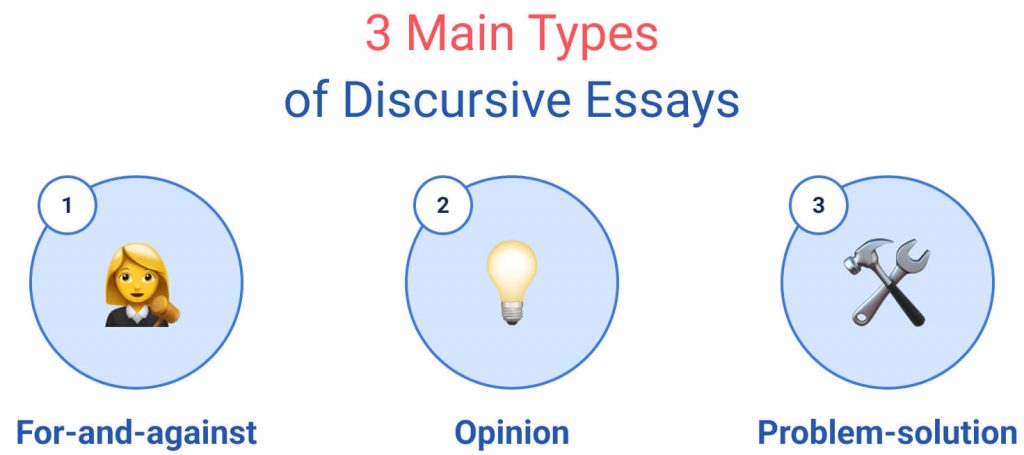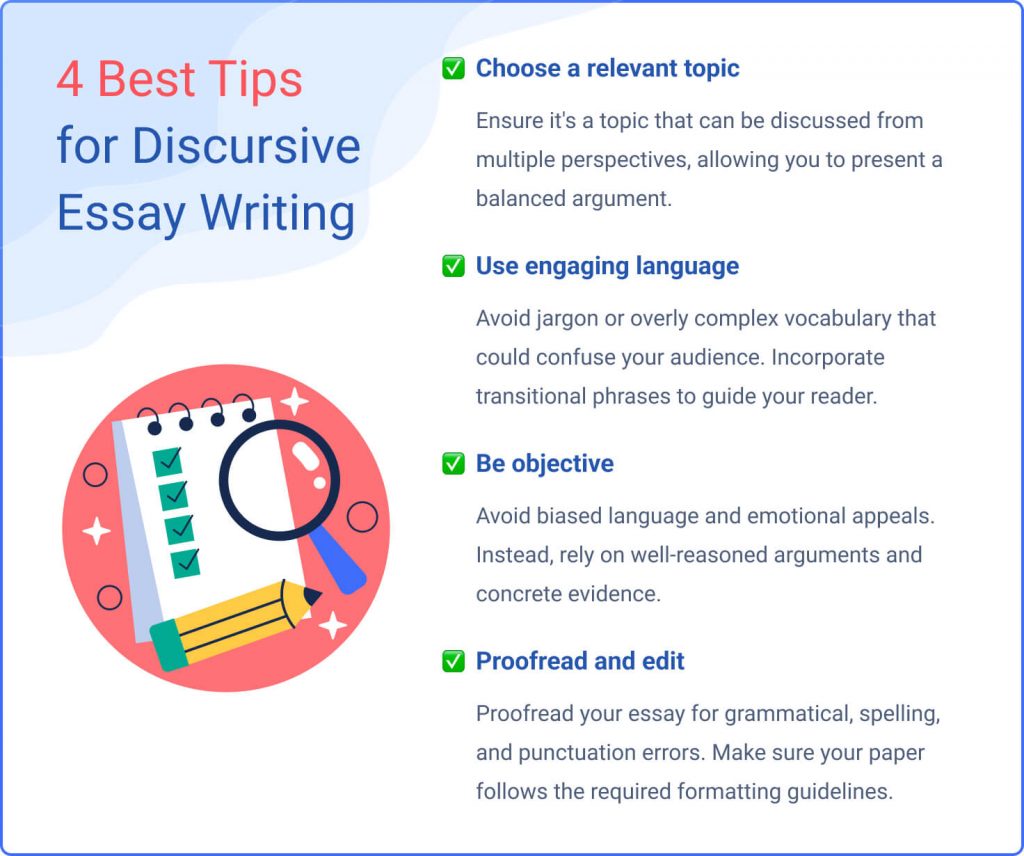
Writing discursive essays is a common task that can be encountered in high school and college environments. Mastering the nuances of writing them will be a lot easier with this guide. Our team has prepared recommendations that cover the basics of discursive essays and their format. Additionally, you will find some helpful tips about improving your work. Let’s get started!
🧐 Discursive Writing: Definition & Purpose
Discursive essays are different from the argumentative and persuasive papers you might be used to. Discursive writing allows students to investigate various topics in depth and present different opinions on particular issues. Creating one involves gathering, reading, and assessing supportive evidence. As with other academic papers, discursive ones are built around a thesis statement that outlines the arguments.

Unlike other paper genres like persuasive essays, discursive essays are scarce on personal thoughts. They favor an unbiased look at the subject through the lens of facts and statistics. You can use them to discuss issues related to social norms, the economy, political movements, technology, and similar subjects. Whatever you write about, ensure you methodically cover every side of the issue.
Differences between Argumentative and Discursive Essays
Students often confuse these essay types, so we’ve decided to help you understand the difference. These descriptions will show you how to identify the purpose and tone of these papers and choose the appropriate one to match your writing goals.
✍️ Types of Discursive Writing
If your professor tasks you with this kind of assignment, you have a couple of ways to approach it. As we’ve mentioned before, there are several types of discursive essays. This segment of our article goes into some detail about each of them.

- For-and-against essay. These papers can be best described as a debate in written form. They provide opposing points of view on different topics. For example, such essays may be about the use of fossil fuels, the First Amendment, or the merits of capitalism. It’s vital to provide reasonable and objective arguments in both cases. Readers can come to their own conclusions after reading these discursive papers.
- Opinion essay. In these papers, you should present your opinion about particular issues. Use reason and evidence to back your arguments. Don’t forget to discuss the opposing opinion and explain why it lacks strength. These essays can discuss social, political, and economic topics.
- Problem-solution essay. This discursive essay type discusses a problem and suggests the best solutions for solving it, for example, helping combat the homelessness crisis, climate change, or other issues. Here, students establish the problem, its causes, and the consequences of not addressing them.
💡 Examples of Discursive Essay Topics
If you get to write a discursive essay on any subject you wish, this is the right segment for you. Here, we provide several pressing, engaging, and diverse topics for your work.
- Does social media affect people’s communication skills?
- Do people rely on technology too much?
- The environment is the prime factor in forming a person’s identity.
- Examine the history of vaccines and their effectiveness.
- What’s the best way to save the environment?
- Does technology make us lazier?
- Higher education is not for everybody.
- Should capital punishment be abolished?
- Therapy is the best way to deal with mental health issues.
- People should travel without borders.
- How much does culture influence a person’s upbringing?
- Is American education in dire need of change?
- Discuss how music provides stress relief.
- German is one of the most complex languages to learn.
- How to combat the drug crisis in America.
- Which book format is the best?
- Are TV shows oversaturated with violence?
- Discuss the link between poverty and crime.
- In modern media, censorship comes before facts.
- Approaches to addressing Higher English course challenges.
- Should special sports events be held for steroid users?
- Does alcohol harm the social fabric?
- Modern movies lack the creative touch.
- Is it OK to control the freedom of speech?
- Discuss if the government should regulate marital relationships.
- Have apps destroyed the dating market?
- The beauty industry wrecked the self-image of women.
- Does listening to heavy metal make a person more aggressive?
- Is religion underappreciated?
📝 Discursive Essay Format
You may be tempted to write right away after choosing the appropriate topic for your discursive essay. However, before you do this, get acquainted with this paper’s format. Below, you’ll find a step-by-step guide for each section of the work.
How to Write a Discursive Essay Introduction
Crafting a compelling intro is the foundation of a successful discursive essay. This section outlines the essential elements and strategies to grab the audience’s attention. Read it to master the art of engaging intros.
- Conduct thorough research. Before writing the introductory part, look for reliable sources of information to draw from. Take the time to find supporting evidence, especially when working on an unknown topic.
- Start with a hook sentence. You can provide stats, pose a good question, or give a quote related to the topic. Since it’s the first impression you make, ensure it’s a memorable one.
- Follow with a compressed topic description in a couple of sentences. Your job is to show how the topic is relevant to the broader discourse. Pick your words carefully to leave a lasting impact.
- Introduce your thesis statement. In a sentence or two, describe the paper’s main idea and how you will disclose it later. Trim it down and edit until the statement perfectly encapsulates the core of your writing.
- Describe what the essay will be about. In a couple of sentences, explain what each part of the work will cover in its paragraphs.
- Finish with a transitional phrase or sentence. The last part of the introduction should also smoothly transition into the paper’s body paragraphs. It makes the writing more cohesive and forms a flowing narrative.

How to Write Discursive Essay Body Paragraphs
The body paragraphs offer a platform for in-depth analysis and presentation of multiple perspectives. The ones in discursive essays have distinctive characteristics that distinguish them from other papers.
- Fill each paragraph with evidence that supports your claims. Add facts, statistics, examples, and quotes. Analyze this content and show how it supports your statements.
- Aim to present a balanced discussion. Give each point of view fair consideration. Even if you have a strong personal opinion, it should not dominate the main arguments.
- Present an opposing point of view. Don’t forget to dedicate several sections for counter-arguments to make the paper more comprehensive. Provide supporting information to these claims and refute them later on.
- Use transitional phrases between perspectives. Smooth transitions between different viewpoints within the body paragraphs will help you maintain coherence and guide the reader through the diverse arguments.
- Work in a structure. The first paragraph produces an argument, while the second has an opposing one. Repeat this process throughout the essay to give your audience a bigger picture of the issue. Also, don’t forget to check your punctuation.
How to Write a Discursive Essay Conclusion
This section will show you how to restate your main points, complete your arguments, and leave a lasting impression.
- Return to the thesis statement. Don’t simply restate it. Instead, show how the paper helped expand upon it. Explain the importance of your work in the broader discussion.
- Remind about the critical points of the paper. Give a rundown of the main takeaways of your paper and why they matter. Stay brief and remember that the conclusion should be about one paragraph long.
- Demonstrate its importance. Tell the readers about the questions your paper raises and how they help understand the issue better. Offer practical suggestions for addressing the problem while relying on the provided data.
- Encourage future discussions. Your paper should make readers want to explore the topic on their own, and it should encourage further debates. Suggest other areas relating to your topic that could be investigated in the future.
💎 Developing a Discursive Writing Style
You’re one step closer to writing your perfect essay. We recommend practicing to ensure that you triumph over these academic tasks. Follow our tips, and you will see the quality of your papers reach new heights.
We thank you for your attention. Hopefully, you’ve found the guide helpful. If you need any more ideas for your discursive essay, you can create one using our topic generator!